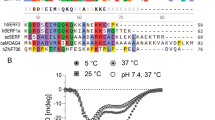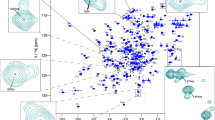Abstract
Src Homology 2 and 3 (SH2 and SH3) are two key protein interaction modules involved in regulating the activity of many proteins such as tyrosine kinases and phosphatases by respective recognition of phosphotyrosine and proline-rich regions. In the Src family kinases, the inactive state of the protein is the direct result of the interaction of the SH2 and the SH3 domain with intra-molecular regions, leading to a closed structure incompetent with substrate modification. Here, we report the 1H, 15N and 13C backbone- and side-chain chemical shift assignments of the partially deuterated Fyn SH3–SH2 domain and structural differences between tandem and single domains. The BMRB accession number is 27165.


Similar content being viewed by others
References
Boggon TJ, Eck MJ (2004) Structure and regulation of Src family kinases. Oncogene 23:7918–7927
Cheung MS, Maguire ML, Stevens TJ, Broadhurst RW (2010) DANGLE: A Bayesian inferential method for predicting protein backbone dihedral angles and secondary structure. J Magn Reson 202:223
Delaglio F, Grzesiek S, Vuister GW, Zhu G, Pfeifer J, Bax A (1995) NMRPipe: a multidimensional spectral processing system based on UNIX pipes. J Biomol NMR 6:277–293
Elias D, Ditzel HJ (2015) Fyn is an important molecule in cancer pathogenesis and drug resistance. Pharmacol Res 100:250–254
Elias D, Vever H, Laenkholm AV, Gjerstorff MF, Yde CW, Lykkesfeldt AE, Ditzel HJ (2015) Gene expression profiling identifies FYN as an important molecule in tamoxifen resistance and a predictor of early recurrence in patients treated with endocrine therapy. Oncogene 34:1919–1927
Grant SK (2009) Therapeutic protein kinase inhibitors. Cell Mol Life Sci 66:1163–1177
Grant SG, O’Dell TJ, Karl KA, Stein PL, Soriano P, Kandel ER (1992) Impaired long-term potentiation, spatial learning, and hippocampal development in fyn mutant mice. Science 258:1903–1910
Huculeci R et al (2016) Dynamically coupled residues within the SH2 domain of Fyn are key to unlocking its activity. Structure 24:1947–1959
Johnson BA, Blevins RA (1994) NMR view: a computer program for the visualization and analysis of NMR data. J Biomol NMR 4:603–614
Kay LE, Torchia DA, Bax A (1989) Backbone dynamics of proteins as studied by 15N inverse detected heteronuclear NMR spectroscopy: application to staphylococcal nuclease. Biochemistry 28:8972–8979
Kojima N, Ishibashi H, Obata K, Kandel ER (1998) Higher seizure susceptibility and enhanced tyrosine phosphorylation of N-methyl-D-aspartate receptor subunit 2B in fyn transgenic mice. Learn Mem 5:429–445
Li X et al (2003) Alphavbeta6-Fyn signaling promotes oral cancer progression. J Biol Chem 278:41646–41653
Manning G, Whyte DB, Martinez R, Hunter T, Sudarsanam S (2002) The protein kinase complement of the human genome. Science 298:1912–1934
Nakazawa T et al (2001) Characterization of Fyn-mediated tyrosine phosphorylation sites on GluR epsilon 2 (NR2B) subunit of the N-methyl-D-aspartate receptor. J Biol Chem 276:693–699
Nietlispach D et al (1996) An approach to the structure determination of larger proteins using triple resonance nmr experiments in conjunction with random fractional deuteration. J Am Chem Soc 118:407–415
Nygaard HB, van Dyck CH, Strittmatter SM (2014) Fyn kinase inhibition as a novel therapy for Alzheimer’s disease. Alzheimers Res Ther 6:8
Ohnuma T, Kato H, Arai H, McKenna PJ, Emson PC (2003) Expression of Fyn, a non-receptor tyrosine kinase in prefrontal cortex from patients with schizophrenia and its correlation with clinical onset. Brain Res Mol Brain Res 112:90–94
Panchamoorthy G et al (1994) Physical and functional interactions between SH2 and SH3 domains of the Src family protein tyrosine kinase p59fyn. Mol Cell Biol 14:6372–6385
Panicker N et al (2015) Fyn kinase regulates microglial neuroinflammatory responses in cell culture and animal models of parkinson’s disease. J Neurosci 35:10058–10077
Pawson T (1995) Protein modules and signalling networks. Nature 373:573–580
Prybylowski K, Chang K, Sans N, Kan L, Vicini S, Wenthold RJ (2005) The synaptic localization of NR2B-containing NMDA receptors is controlled by interactions with PDZ proteins and AP-2. Neuron 47:845–857
Roskoski R Jr (2015) Src protein-tyrosine kinase structure, mechanism, and small molecule inhibitors. Pharmacol Res 94:9–25
Rossi P et al (2010) A microscale protein NMR sample screening pipeline. J Biomol NMR 46:11–22
Saito YD, Jensen AR, Salgia R, Posadas EM (2010) Fyn: a novel molecular target in cancer. Cancer 116:1629–1637
Saksela K, Permi P (2012) SH3 domain ligand binding: What’s the consensus and where’s the specificity? FEBS Lett 586:2609–2614
Sato I et al (2009) Differential trafficking of Src, Lyn, Yes and Fyn is specified by the state of palmitoylation in the SH4 domain. J Cell Sci 122:965–975
Sicheri F, Kuriyan J (1997) Structures of Src-family tyrosine kinases. Curr Opin Struct Biol 7:777–785
Suzuki T, Okumura-Noji K (1995) NMDA receptor subunits epsilon 1 (NR2A) and epsilon 2 (NR2B) are substrates for Fyn in the postsynaptic density fraction isolated from the rat brain. Biochem Biophys Res Commun 216:582–588
Ulmer TS, Werner JM, Campbell ID (2002) SH3-SH2 domain orientation in Src kinases: NMR studies of Fyn. Structure 10:901–911
Vranken WF et al (2005) The CCPN data model for NMR spectroscopy: development of a software pipeline. Proteins 59:687–696
Xu W, Doshi A, Lei M, Eck MJ, Harrison SC (1999) Crystal structures of c-Src reveal features of its autoinhibitory mechanism. Mol Cell 3:629–638
Young MA, Gonfloni S, Superti-Furga G, Roux B, Kuriyan J (2001) Dynamic coupling between the SH2 and SH3 domains of c-Src and Hck underlies their inactivation by C-terminal tyrosine phosphorylation. Cell 105:115–126
Acknowledgements
This research is funded by the Flemish Scientific Fund (F.W.O.) via the grant G025915N. The VIB and the Jean Jeener NMR Center provided further support for our work.
Author information
Authors and Affiliations
Corresponding author
Additional information
In Memoriam Nico van Nuland.
We would like to dedicate this article to the memory of our colleague and friend Nico van Nuland who passed away on November 4, 2017, without whom this research would not have been possible.
Rights and permissions
About this article
Cite this article
Kieken, F., Loth, K., van Nuland, N. et al. Chemical shift assignments of the partially deuterated Fyn SH2–SH3 domain. Biomol NMR Assign 12, 117–122 (2018). https://doi.org/10.1007/s12104-017-9792-1
Received:
Accepted:
Published:
Issue Date:
DOI: https://doi.org/10.1007/s12104-017-9792-1




